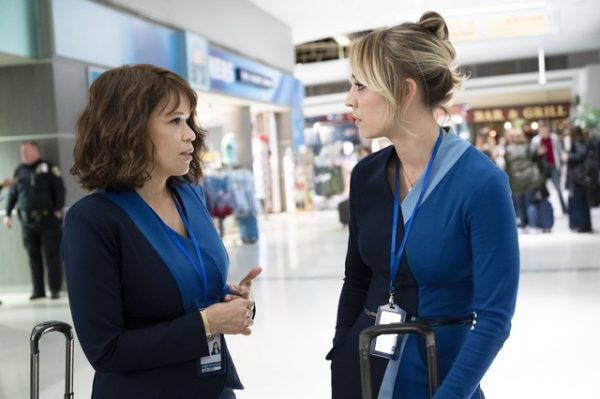Production Designer Sara K White brings a unique perspective to The Flight Attendant, which pays homage to revered film makers such as Alfred Hitchcock. By manipulating perspective, drip feeding information and keeping audiences guessing this HBO Max original proves riveting throughout. When Sara recently took time out to talk to Martin Carr about her involvement, she proved eloquent, informed and passionate about both her process and the project.
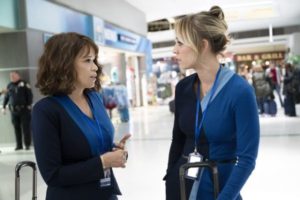
The Flight Attendant is an old fashioned murder mystery with a modern twist. In terms of production design what were your influences?
I drew my main inspiration from the story itself and the characters which exist within it. There were also extensive conversations with Susanna Fogel, the director, and Steve Yockey, the creator, discussing the dichotomies which could exist in our sets and the way to exploit them in unpacking that central mystery. There were strong Hitchcockian themes in the way the spaces were described, which absolutely informed my reading of the script. However my primary influences stemmed from these unique characters and the spaces they inhabit within this story.
As this show moves locations so much, what were the most important creative choices which needed addressing?
The show explores a number of different contradictions within Cassie, comparing her small town upstate existence to her role at a luxurious airline travelling to far flung destinations. There are also these places where we explore the lies and deceit within this murder mystery, as well as contrasting that with the various organisations which are influential in her life. We also spent a lot of time thinking about that main space of the hotel suite in terms of reflections, refractions and obscuration, focusing on the idea of being able to explore through the built environment and in camera the ways trauma might be experienced by a person. It was really important to the project and key as we revisit the suite so often as Cassie tries to piece together this mystery.
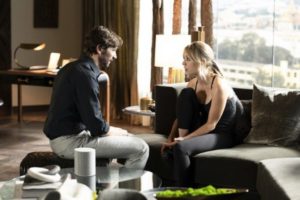
How important was it to your involvement that The Flight Attendant had a strong female protagonist?
It’s always exciting to have a main character that doesn’t reveal everything from the jump. I think what remains amazing about Cassie throughout, are not only her characteristic flaws but how these make her infinitely relatable. Whether everyone is the kind of party girl Cassie was or not, beneath those flaws is a genuine person which draws audiences to her. It’s a trait which instils trust, meaning people want to support her and stay with her as she goes through this journey. It was important for me to support a story that represents characters that are not always seen, or perhaps not always given the creative journey they should be.
She doesn’t trust or believe herself and Cassie needs to come to terms with that. For me that was one of the most exciting parts in telling this story, supporting ways for her to experience that journey and for it to be brought to life in intimate detail. I loved providing the audience with an opportunity to relate to her on a genuine level.
In terms of production design how did you address the way scenes were divided up?
One thing we talked about a lot was the idea of broken symmetries, which was something we were able to explore in physical form quite successfully I think. Depending on your vantage point in any number of spaces she inhabits, you might be confronted by a strong symmetrical visual, which feels complete. However, if you step just a few feet to the left or right that strength will be broken and things will be hidden, or unexpectedly revealed in a way that comes out of leftfield. That was something we tried to bring into every space, constantly allowing the audience and Cassie to have their viewpoint changed, controlling the flow of information throughout the mystery.
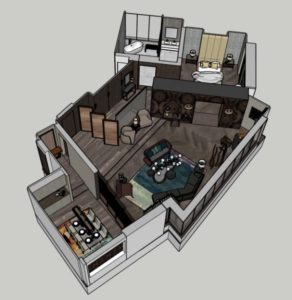
Many of the key dialogue scenes happen in a hotel room. How important was that location as whole in terms of production design?
It was essential for the telling of this story. She spends so much time coming back to that space and it evolves as we experience her journey. When Cassie first goes there it’s to have the night of her life with this mysterious stranger. We’re drawn in and enraptured by this glamour which soon turns into something more sinister. Making sure the space allowed that transformation and continued to support it throughout this series was incredibly important. We worked very hard to ensure every scene could offer the audience a different perspective and conceal or reveal clues, making it this constantly mutating space.
I know Susanna Fogel through her work on Booksmart, but on this project what was her creative input in terms of conversations you shared?
Susanna and I had already worked together on a pilot called The Wilds, so we had a shorthand coming into The Flight Attendant. We both wanted to make sure the audience journey in the mystery was at the forefront of our choices, when it came to how we saw these spaces. It was important to bear in mind how they we were brought into Cassie’s understanding of this situation, either by acknowledging or ignoring certain information at any given time. That became a cornerstone of our initial collaboration as well as ensuring that these worlds, which on the surface are very disparate, end up cohesive both in terms of story and as a whole.
How did the production design contribute to the ever changing tone so successfully within this show?
The primary objectives in telling the story came about from the collaboration of all our key creatives. We wanted to keep in mind Cassie’s understanding of events as they unfolded. And we had to consider what was clear or otherwise from other points of view, both for the people trying to hurt her and those helping her as she undertakes her own investigation in what happened. We wanted to really inhabit the events as they happen in those first two episodes. We kept in mind her confusion and determination as a means to understand how we see each and every space.
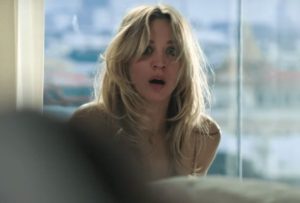
What makes a project more appealing, is it the creative challenges or the story itself?
It is really hard to have one without the other and remain excited, especially for a project like this which lasted twelve months. For me it’s about making sure story elements continue to expand and explore aspects of humanity through genuine human stories. It in turn allows me to examine who we see in these stories and why we see them in the way that we do. In The Flight Attendant that happened through Cassie’s character, and it allowed me tremendous design opportunities. I am most enthralled by story, but in every instance it’s nice to have both.
Describe for me your perfect Sunday afternoon.
I love long lazy mornings with a cup of coffee, a book or sketch book and maybe going for a nice jog in the park. Then finishing the day with a good meal or cocktail with friends – in a socially distanced outside location of course.
Many thanks to Sara K White for taking the time for this interview.
The Flight Attendant premieres on HBO Max November 26th.



